
- •Stahara publishing company
- •Lesson 1.
- •Instead of trying to free your wrists by the strength of your arms, you force them out by the strength of the abdomen and the weight of the body.
- •Instead of memorizing this as an abstract principle, visualize it in the concrete instance of the simple trick exemplified on the preceding page.
- •Ichi II-gatashi.
- •Lesson 2.
- •In fact, in a five minutes bout in jujitsu each will have made the other quit several times and they will always keep smiling.
- •Lesson 3.
- •Lesson 4.
- •Lesson 5.
- •Lesson 7.
- •In short, they wanted to train, not only the muscular endurance of the soldier, but his morale, or fighting spirit.
- •Lesson 8.
- •Lesson 9.
- •Lesson 10.
- •Lesson 11.
- •In practice put strength into the blow but stop it a few inches from his neck. With this blow it is an easy matter to knock a man out.
- •Lesson 12.
- •Lesson 13.
- •Summary
- •Lesson 14.
- •Seized from behind -- Fig. 82
- •Lesson 15.
- •Lesson 16.
- •In practice exert only sufficient pressure to force opponent to give the signal of defeat.
- •Lesson 19.
- •Lesson 20.
- •Lesson 21.
- •Lesson 22.
- •Lesson 23.
- •Lesson 24.
- •In teaching men who were going to the war, all the training was directed towards making them kick or hit a vital spot rather than try for a hold.
- •It seems that the burglar threatened him by brandishing a two-handed, razor-edged Japanese sword over his head, and demanded his money.
- •Lesson 25.
- •Lesson 26.
- •Lesson 27.
- •Lesson 28.
- •Lesson 29.
- •Lesson 30.
- •Lesson 31.
- •In practice, do this so slowly that there is no danger of injuring your opponent's elbow. He will stand still and let you experiment, and you must allow him the same privilege.
- •Lesson 32.
- •Lesson 33.
- •Lesson 34.
- •Lesson 35.
- •Lesson 36.
- •In practice do it slowly and release him the instant he quits.
- •Lesson 37.
- •Lesson 38.
- •Lesson 39.
- •Verbum sap: a word to the wise is sufficient
- •Lesson 42.
- •Lesson 43.
- •Lesson 44.
- •Lesson 47.
- •Lesson 48.
- •It is not recommended as a practical fighting trick, as it leaves you open to a kick just before it is secured.
- •Lesson 51.
- •Lesson 52.
- •Lesson 53.
- •If you start too roughly at first with one another, you will never continue your practice to the point of proficiency. Advanced practice in throwing man from behind
- •Lesson 54.
- •Lesson 55.
- •Lesson 56.
- •If the escape be executed before Assailant gets his full pressure on your neck, it is easy to get away.
- •Lesson 57.
- •If you do it gently, not only is there no danger, but no discomfort.
- •Lesson 58.
- •Lesson 59.
- •If you are on patrol duty and see an enemy ahead of you whom you must "get" without letting him give the alarm, steal up silently and get him unawares.
- •Lesson 60.
- •Lesson 62.
- •In practice, be gentle. In actual attack knock him out, or at least render him speechless, by a sharp blow on the windpipe with the wrist.
- •The scope of this course
- •"It isn’t whether we win or lose, but how we play the game."
Lesson 4.
This lesson gives you an example of maneuvering opponent's hand to such a position that it becomes relatively weak.
You are then taught the principle it embodies. You will apply this principle to every hold you practise. KNOWLEDGE CONQUERS STRENGTH
The underlying principle in this lesson is:
In each trick get your opponent so that he can resist you with only 20 percent of his strength
And conversely
Use your body so that you are exerting 100 percent of your strength at the point where he is opposing only 20 percent of his.
A little practice of this experiment will teach you to act automatically on this principle in all tricks. In order not to hurt one another's wrists do this practice slowly but firmly.
The value of this exercise lies not in the intrinsic merit of the wrist-twist as a fighting trick but in enabling you to apply this principle in your future practice, automatically, without having to try to remember it.
NULLIFYING OPPONENT'S STRENGTH
Take
the Wrist-twist grip. Let your opponent relax his a
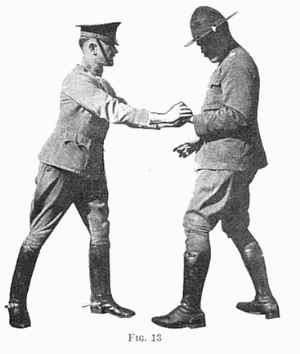 rm.
Pull your elbows close to your sides, thus straightening his arm.
rm.
Pull your elbows close to your sides, thus straightening his arm.
Twist his wrist slowly, not by hand pressure alone, but by turning your body also.
He is powerless to prevent you as he can only oppose the strength of his wrist against the strength of your whole body. YOUR OWN STRENGTH NULLIFIED
Relax your arms. Let your opponent slowly pull his elbow close to his side, clenching his fist, with strength and balance in his Stahara.
(Do not move your feet in this experiment.)
You will now find it impossible to twist his wrist.
This is because you are exerting the strength of your wrist only against the strength of his whole body.
Lesson 5.
This
lesson shows clearly by means of two photographs the secret of
Stahara Control, and teaches you how to a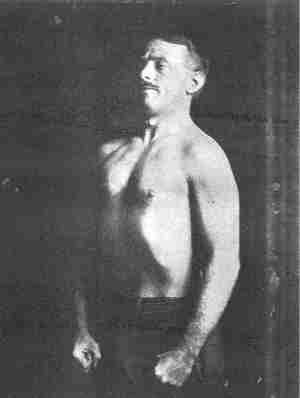
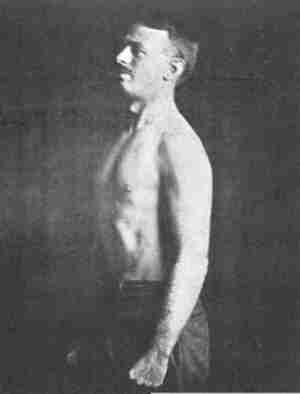 pply
it.
pply
it.
Fig 14: CENTER OF GRAVITY TOO HIGH -- INCORRECT
NO STRENGTH IN THE STAHARA -- THE ABDOMINAL REGION
Body weak -- easily unbalanced.
Connection between arms and legs absent.
Body cannot move quickly.
Fig 15: CENTER OF GRAVITY LOW -- CORRECT
THE STAHARA -- ABDOMINAL REGION -- FULL OF STRENGTH
Body strong -- well balanced.
Proper connection between arms and legs.
Body able to move quickly.
STAHARA CONTROL
Standing in position of fig. 15 force your stomach, abdomen and diaphragm down as if you were trying to force your abdomen outward against your belt, to make your belt feel tight, as it were.
Check this outward movement by the stomach muscles. Hold your breath hard for a few seconds.
Do not strain yourself in any way. Just keep practising it gently thruout the day whenever you happen to think of it.
Practise it for a few minutes before a mirror keeping your face impassive and preventing any trace of effort showing. You will soon be able to do this without holding your breath.
Keep your head up and shoulders back but have all your muscles relaxed. STAHARA CONTROL HELPS QUICK MOVEMENT
Dance around the room imitating the movements of a boxer -- this is called "shadow boxing." First raise your ribs as high as you can, as in fig. 14.
Next dance around with Stahara control, as in fig. 15. Note how much more under control your movements are, the connection between your arms and legs is much better; you can put more punch into your arm movements.
Stahara control teaches you to keep limber all over, even your Stahara is not tensed, and it enables you to concentrate all your effort in the proper muscles at the proper time.
AN EASY EXPERIMENT
TRY THIS
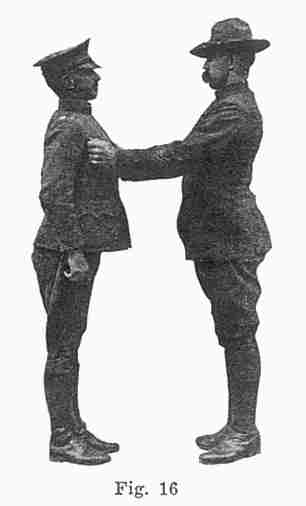
Stand at attention, head up, shoulders back. Throw your chest out, raising the ribs thus showing what physical culturists call "The Grecian Arch," as shown in fig. 14.
In this position let a friend seize your coat at the shoulders with finger and thumb of each hand, and slowly pull until you lose your balance and fall forward.
It takes but a small effort on his part as your center of balance is too high and your waistline is weak.
Again stand at attention, but do not raise your Grecian Arch. Tense your abdominal muscles, as shown in fig. 15 but without drawing the stomach in. Press the stomach out and against your belt.
Have your friend pull you forward as before. Stand still, do not move the feet. Note how much better you keep your balance.
He will note how much heavier you feel, and, using the same amount of strength as before he will be unable to pull you forward.
Try these two experiments on your friend. In number 1, use the minimum effort to unbalance him. In number 2, use the same amount of strength, and note how much heavier and stronger he is.
A man who has trained himself to stand and pose with the Grecian Arch showing will be at a disadvantage when he first begins to wrestle or box for when making an effort he will instinctively raise his chest walls.
This raises his center of balance too high and weakens his Stahara -- the connecting link between his arms and legs.
In the first experiment with no control of the Stahara the body is like a ship, made of good material, but in which the rivets are loose.
In the second, the ship is tight and trim, every rivet in its place and holding. Your body is like one solid beam, a trustworthy support for a weighty structure, rather than a pillar made of several timbers loosely bolted together and consequently weak.
Practise this experiment until your face shows no trace of effort and until you can do it easily, tensing only when he pulls and relaxing when he relaxes.
The awkwardness of many men can be traced to their unconsciously raising their Grecian Arch whenever they do anything requiring and effort.
LESSON 6. THE WAIST HOLD
T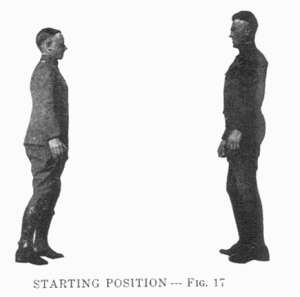 his
lesson teaches you to keep your balance when struggling in a clinch.
his
lesson teaches you to keep your balance when struggling in a clinch.
It is a simple method of accustoming a beginner to personal contact with his opponent. WAIST HOLD STARTING POSITION
The two students stand facing each other at a distance of four to six feet. The heels are eighteen inches apart on the same line. The knees are slightly bent; the body erect and well balanced, limber and not tensed.
Note:
The
Waist Hold is a good exercise for the muscles. It also familiarizes
the beginner with the sensation of being seized and teaches him to
keep cool, thus correcting the tendency of the timid individual to
stiffen up and tense his muscles instead of keeping them limber and
ready for instant action.
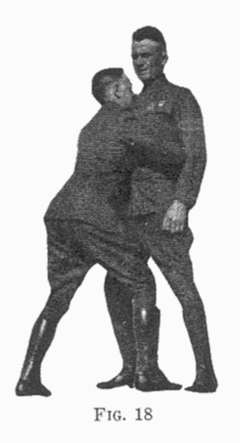
S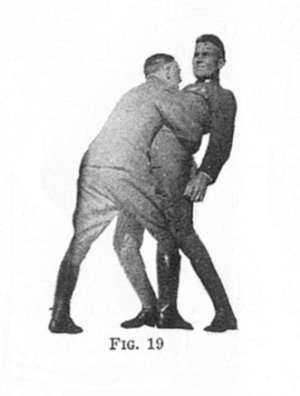 tep
up to opponent. Slip your hands beneath his arms and clasp them
behind his back.
tep
up to opponent. Slip your hands beneath his arms and clasp them
behind his back.
Place your chin on his chest midway between collarbone and nipple.
(Opponent stands still and does not move.)
Bend opponent back by pressing your chin firmly into his chest and pulling his waist towards you.
Do not throw him. The trick is achieved when you unbalance him.
Then release him, return to starting position, and allow him to try it on you.
Do it each three times alternately. HOW TO DEVELOP SUBCONSCIOUS STAHARA CONTROL
A person's natural inclination when gripping anybody is to put all the strength into the limb which performs the immediate action, that is, the hand or the arm.
In seizing a man around the waist, for instance, the tendency is to lean on him utilizing arm strength only and forgetting to keep your balance.
This lesson educates you out of this habit and gives you automatic Stahara control.
This will develop in your brain a "plexus" that will automatically keep your balance in all sorts of positions and grips.
It will also give you such a grasp of the principle that you will unconsciously apply it in every trick you try.
Practise the Waisthold until you automatically keep your balance every time and never hold on by arm strength alone.
While doing this exercise you are thinking of two things:
First: To keep your balance.
Second: To check any tendency to raise the chest wall.
You would be surprised at the number of people who raise their chest walls (as in fig. 14) when they exert strength.
At first you will have to think hard of your balance and your Stahara, but after a few practices you will keep your balance without having to think so hard, you will also find that you have more control of the Stahara.
That means that your subconscious mind is learning to take care of these operations leaving the active mind free to attend to the details of the new tricks.
